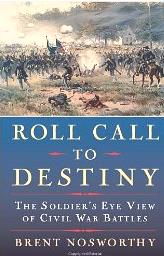


Book Review Additional Information
Roll Call To Destiny: The Soldiers Eye View of Civil War Battles by Brent Nosworthy Reviewed by Jim Seguin As an interesting but brief exercise, and in the hope providing thoughtful reflection among the membership, a review of the tactical observations in Roll Call To Destiny are described below. Tactical Observation #1 (The Rifled Musket) Mr. Nosworthy makes the point that given the large number of rounds expended from the rifled muskets and the relatively few casualties that resulted was due in large part to the lack of courage of the soldiers engaged. It is not realistic to suggest that a large part of the rank and file of all armies north and south in all theaters of operations throughout the war "were barely able to control their muscles." He suggests that the characteristics of the rifled musket and mini ball compounded the inability of nervous soldiers to put rounds on target at close range. On this point there is data that reflects the difficulty of accurately putting rounds down range. Prewar theoretical analysis of the rifled musket and mini ball predicated long range infantry engagements given the far greater lethal range of the rifled musket over the smoothbore musket. The Confederate Field Manual explained range data and indicated that "serious wounds" would be inflicted at distances beyond 3000 feet with the rifled musket. Empirical data after the war suggests that engagements where the rifled musket dominated the typical range between the antagonists was only 3 times greater then that of the American revolution or about 900 feet, far less then predicted theoretically and on this point Mr. Nosworthy is correct but he puts the blame on the soldier rather than the weapon to accurately place rounds on target. Mr. Nosworthy states that the lower muzzle velocity of the mini ball used in the rifled musket created a greater parabolic trajectory of the projectile and made it more difficult to put rounds on target at longer ranges over the round ball used in the smoothbore musket. My own range work, using a rifled replica Euroarms Enfield showed that using a round ball was more accurate than the mini at 300 feet and that fouling from powder had a greater impact on the mini with as few as five rounds. Add to this the amount of trigger pull required to squeeze off a round and the difficulty of acquiring a target through iron sights at 300, much less 900 feet, greatly diminished the ability of the standard infantry issue rifles to tightly group shots. The difficulty of operation, fouling and the erratic ballistic patterns of these weapons and the propensity of line officers to repeatedly order their commands to volley fire made accurate rifle fire problematic. Couple with loose order formations used later in the war are, in my view, the primary reasons so few casualties were experienced to the amount of ammunition expended. Tactical Observation #2 (The Bayonet Charge) Mr. Nosworthy points out that bayonet wounds as a percentage of all wounds are statistically insignificant and makes the argument that bayonet fighting was not the same as a bayonet charge. True! But he goes on to argue that the bayonet charge was intended to "destroy the enemies will to stay and fight" by quickly closing and overwhelming the defenders by closed formations at the shiny point of a bayonet. He cites that the Third Alabama and the Forty-First Virginia ran when flanked at Fair Oaks by the Fifty-Seventh New York when they "launched a bayonet charge" and that this happened over and over again throughout the war and he poses the question, "What are these but examples of successful bayonet charges?" The term bayonet charge in this context is a metaphor to describe the use of close order combat to capture key positions rather than the literal use of cold steel as a preferred tactic. The charges on May 10th and 12th 1864 at Spotsylvania by Emery Upton and Hancock's II Corps to gain control of the salient are examples that could here be described as bayonet charges. This tactical observation does not add insight to the specific impact or use of bayonets. How many instances are there of generals rhetorically if not wistfully thinking what they could accomplish if they had troops with the ‚lan to fight in close! Tactical Observation #3 (The Cavalry Saber) Mr. Nosworthy makes the argument that as the war progressed federal cavalrymen preferred the saber to firearms and points to several smaller fluid battles in which the federals were successful using the saber to support his point. He goes on to write that this caused southern cavalrymen to adapt and request sabers to counter these successes. However, he overlooks overwhelming evidence that cavalry were used primarily as screening forces, file closers to curb straggling and in the case of the federal cavalry, were most effective in a dismounted role using repeating rifles. Buford's cavalry division on the first day at Gettysburg is perhaps the most salient example of dismounted cavalry using repeating rifles. At best a mixed picture emerges from the war over the preferred weapon of choice but as the war progressed the better equipped federals were outfitted with rifled weapons particularly repeating weapons like the Sharps, Spencer and Henry rifles among others. ISBN 10: 0-7867-1747-5 Jim Seguin
RCWRT Members, if you would like to share a CW book report on our web site, please mail it to: cowardin@juno.com (E-mail either as text or a .doc attachment)
Return to Book Report Index
Return to main page

©R.C.W.R.T. 2000-2001